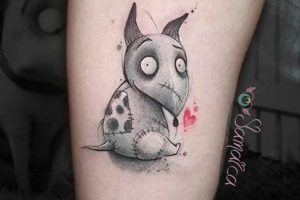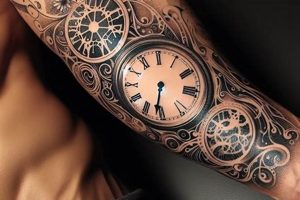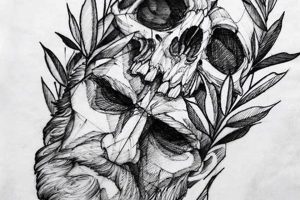Concepts for body art featuring serpents encompass a wide range of styles, sizes, and symbolic meanings. Examples include realistic depictions of specific species, stylized representations incorporating geometric patterns, or symbolic imagery interwoven with other elements like flowers or skulls. The choice of design often reflects personal aesthetics, cultural beliefs, or desired symbolism.
Serpent body art holds significance across various cultures, often representing transformation, rebirth, healing, and protection. Historically, serpents have been revered as powerful symbols of life force and the cyclical nature of existence. Choosing this type of design allows individuals to express personal narratives, connect with ancestral traditions, or embody specific qualities they admire. This enduring appeal stems from the rich symbolism and adaptable artistry associated with serpentine forms.
Further exploration will delve into popular design motifs such as the cobra, rattlesnake, and viper; stylistic variations ranging from traditional Japanese to modern minimalist; and symbolic interpretations related to healing, wisdom, and guardianship. Considerations regarding placement, color palettes, and the selection of a reputable artist will also be addressed.
1. Species
The specific species of serpent chosen for a tattoo significantly impacts the design’s overall aesthetic, symbolic meaning, and cultural resonance. Careful consideration of the species’ natural characteristics, associated symbolism, and artistic potential is essential for creating a meaningful and impactful piece of body art.
- Venomous vs. Non-Venomous
Depicting a venomous species like a cobra or viper often evokes themes of danger, power, and protection, while non-venomous snakes such as pythons or boas can represent healing, transformation, and life cycles. The choice reflects the individual’s desired message and personal connection to these qualities.
- Cultural Significance
Certain species hold specific cultural significance. For example, the cobra is revered in many Asian cultures as a symbol of divinity and protection, while the rattlesnake holds symbolic weight in Native American traditions. Understanding these cultural nuances adds depth and authenticity to the design.
- Physical Attributes
The unique physical attributes of different species offer diverse artistic possibilities. The vibrant scales of a coral snake, the distinctive hood of a cobra, or the sinuous form of a green mamba each provide distinct visual elements that can be emphasized in the tattoo design.
- Habitat and Behavior
A snake’s natural habitat and behavior can also inform the overall design. A snake depicted coiled around a tree branch evokes different imagery and symbolism than one shown striking or swimming. These elements can enhance the narrative and visual impact of the tattoo.
Ultimately, the chosen species serves as the foundation upon which the entire tattoo design is built. It informs the artist’s stylistic choices, color palette, and composition, resulting in a piece of body art that resonates with the individual’s personal narrative and desired aesthetic.
2. Style
Artistic style significantly influences the visual impact and overall aesthetic of serpent body art. Selecting a style that aligns with personal preferences and the intended symbolism is crucial for creating a meaningful and visually compelling tattoo. The chosen style dictates the use of line, color, shading, and composition, transforming the depiction of the serpent from a simple image into a personalized work of art.
- Realism
Realistic depictions prioritize anatomical accuracy and detail, capturing the intricate textures and patterns of the snake’s scales, eyes, and musculature. This style often incorporates lifelike shading and color palettes to create a three-dimensional effect, making the serpent appear almost tangible on the skin.
- Traditional
Traditional styles, such as American Traditional or Japanese, employ bold lines, vibrant colors, and simplified forms. These styles often depict serpents with stylized features, emphasizing symbolic elements like fangs or coiled postures. Traditional serpent tattoos frequently incorporate other imagery, like flowers or daggers, contributing to a cohesive and symbolic narrative.
- Geometric
Geometric styles incorporate abstract shapes and patterns, often integrating the serpent’s form with geometric elements like triangles, squares, and circles. This style emphasizes clean lines and precise angles, creating a modern and visually striking design. Geometric serpent tattoos can represent balance, symmetry, and the interconnectedness of nature.
- Watercolor
Watercolor tattoos emulate the fluid and vibrant nature of watercolor paintings, utilizing soft color gradients and splashes of pigment to create a dreamlike and ethereal aesthetic. This style lends itself well to depicting serpents in motion or intertwined with other elements, such as flowers or water, allowing for artistic expression and a sense of movement.
The interplay between the chosen serpent species and the artistic style ultimately determines the tattoo’s overall impact. A realistic depiction of a king cobra evokes a different feeling than a geometric representation of a rattlesnake. Careful consideration of both elements ensures a cohesive and meaningful design that effectively communicates the intended symbolism and personal aesthetic.
3. Symbolism
Symbolism plays a crucial role in the design and interpretation of serpent body art. The serpent’s rich history across various cultures imbues it with diverse meanings, making it a powerful symbol for personal expression. Understanding these symbolic associations adds depth and significance to the chosen design, transforming a simple image into a potent representation of personal beliefs, values, or aspirations.
- Transformation and Rebirth
Shedding its skin, the serpent embodies cyclical renewal, representing transformation, rebirth, and the continuous cycle of life, death, and regeneration. This symbolism resonates with individuals undergoing significant life changes or embracing personal growth. A serpent tattoo can serve as a reminder of resilience, adaptability, and the constant potential for positive change.
- Healing and Medicine
The Rod of Asclepius, featuring a serpent entwined around a staff, is a widely recognized symbol of healing and medicine. This association stems from the serpent’s perceived ability to shed its skin and renew itself, symbolizing restoration and rejuvenation. Serpent tattoos can represent overcoming illness, physical or emotional healing, and the pursuit of well-being.
- Protection and Guardianship
In many cultures, serpents are viewed as protectors, guarding sacred sites and warding off evil spirits. Their ability to sense vibrations and navigate hidden spaces contributes to this perception of vigilance and guardianship. Serpent tattoos can symbolize protection from harm, guidance through challenging times, and the strength to overcome adversity.
- Knowledge and Wisdom
The serpent’s association with wisdom and knowledge appears in various mythologies and folklore. Often depicted as cunning and insightful creatures, they represent the pursuit of knowledge, the mysteries of the unseen world, and the power of intuition. A serpent tattoo can symbolize a thirst for knowledge, a connection to the spiritual realm, and the wisdom gained through experience.
The chosen symbolism significantly influences the overall design and placement of the serpent tattoo. A serpent depicted coiled around a tree of life emphasizes growth and interconnectedness, while a striking cobra symbolizes protection and power. By understanding and incorporating these symbolic layers, individuals can create deeply personal and meaningful body art that resonates with their own unique narratives and aspirations.
4. Placement
Placement significantly impacts the overall aesthetic and symbolic meaning of serpent body art. Consideration of the body’s natural contours, the desired visibility of the tattoo, and the symbolic significance of specific locations contributes to a cohesive and impactful design. Strategic placement enhances the serpent’s sinuous form and emphasizes the chosen symbolism, transforming the tattoo into a dynamic and personalized statement.
- Arms and Legs
The elongated shape of arms and legs provides an ideal canvas for showcasing the serpent’s flowing form. A serpent coiled around the forearm or wrapped around the ankle can create a sense of movement and dynamism. These placements offer versatility in terms of visibility, allowing individuals to choose between easily concealed or readily displayed designs. A serpent ascending the arm can symbolize growth and transformation, while one descending might represent shedding or releasing the past.
- Back and Chest
The larger surface area of the back and chest allows for more elaborate and detailed designs. Large-scale serpent tattoos can incorporate intricate patterns, backgrounds, and additional elements, creating a visually striking centerpiece. A serpent spanning the width of the back can symbolize protection and guardianship, while one coiled around the heart represents deep emotional connection and transformation.
- Ribs and Spine
The curves of the ribs and the vertical line of the spine offer unique placement opportunities for emphasizing the serpent’s natural form. A serpent winding along the ribs can create a sense of intimacy and personal significance, while one following the spine can symbolize the kundalini energy and spiritual awakening. These placements are often chosen for their subtly and personal meaning.
- Hands and Feet
Small, minimalist serpent tattoos on the hands or feet can serve as subtle yet powerful reminders of personal symbolism. A small serpent on the wrist can represent healing and protection, while one on the ankle might symbolize grounding and connection to the earth. These placements offer a discreet way to express personal meaning without drawing excessive attention.
The interplay between placement, style, and symbolism ultimately shapes the narrative and impact of serpent body art. A coiled serpent on the wrist conveys a different message than a large, dynamic serpent spanning the back. Careful consideration of these elements ensures a harmonious and meaningful design that resonates with the individual’s personal aesthetic and desired symbolic representation.
Tips for Choosing Serpent Body Art
Selecting appropriate body art featuring serpents requires careful planning and consideration. These tips offer guidance for navigating the process and ensuring a meaningful, well-executed design.
Tip 1: Research Symbolism: Thoroughly research the symbolic meaning associated with different serpent species and design elements. A cobra symbolizes different concepts than a rattlesnake. Understanding these nuances ensures the chosen design aligns with intended personal meaning.
Tip 2: Explore Diverse Styles: Explore various artistic styles, from realism to traditional Japanese or geometric. Each style evokes a different aesthetic and complements specific serpent species and symbolic representations differently. View portfolios of different tattoo artists to identify a style that resonates.
Tip 3: Consider Placement Carefully: Placement impacts both the visual impact and symbolic meaning of the tattoo. Consider the body’s natural contours and how the design will flow with them. The visibility of the chosen location should also align with personal preferences and lifestyle.
Tip 4: Choose a Reputable Artist: Select a tattoo artist with demonstrable experience in the chosen style and a strong portfolio showcasing high-quality serpent tattoos. Consult with multiple artists to discuss ideas and assess their artistic approach and hygiene practices. A skilled artist can provide valuable insights and ensure the final result meets expectations.
Tip 5: Plan for the Long Term: Tattoos are a permanent form of self-expression. Carefully consider the chosen design and its long-term implications. Avoid impulsive decisions and allow ample time for reflection and refinement of the design before committing to the tattoo.
Tip 6: Think About Color: Color significantly impacts a tattoo’s visual impact. Research color symbolism and consider how different palettes complement the chosen design and skin tone. Discuss color options with the chosen artist to ensure a harmonious and visually appealing result.
Tip 7: Size and Detail: The size and level of detail in the design should be proportionate to the chosen placement and the artist’s skill level. Intricate details may not be feasible on smaller areas. Discuss size and detail with the artist to ensure a well-balanced and aesthetically pleasing tattoo.
Careful consideration of these tips contributes significantly to the creation of meaningful and well-executed serpent body art that resonates with personal aesthetics and symbolic intentions for years to come.
The subsequent conclusion will summarize key considerations and underscore the importance of thoughtful planning in acquiring meaningful and aesthetically pleasing serpent body art.
Frequently Asked Questions about Serpent Tattoos
This section addresses common inquiries regarding the acquisition and care of serpent-themed body art, providing concise and informative responses.
Question 1: What is the average cost of a serpent tattoo?
Pricing varies based on size, complexity, artist experience, and geographic location. Small, simple designs may cost a few hundred dollars, while larger, more intricate pieces can cost several thousand dollars. Consulting multiple artists for quotes is recommended.
Question 2: How painful are serpent tattoos?
Pain levels depend on individual pain tolerance, placement, and tattoo size. Areas with thinner skin or closer to bone tend to be more sensitive. Discuss pain management options with the chosen artist prior to the appointment. Topical anesthetics can sometimes be used.
Question 3: How long does it take for a serpent tattoo to heal?
Healing typically takes 2-4 weeks. Proper aftercare, including regular cleaning and moisturizing, is crucial for optimal healing and preventing infection. Following the artist’s aftercare instructions diligently is essential.
Question 4: Can serpent tattoos be covered up or removed?
Cover-ups and removals are possible, but the complexity and cost depend on the existing tattoo’s size, color, and ink density. Laser removal can be expensive and require multiple sessions. Consult with a reputable tattoo artist or laser removal specialist to discuss options.
Question 5: Are there any cultural sensitivities to consider when choosing a serpent tattoo?
Serpents hold diverse symbolic meanings across cultures. Researching the cultural significance of chosen designs, particularly when incorporating elements from specific traditions, is essential to avoid unintentional misrepresentation or appropriation.
Question 6: What are the best practices for choosing a reputable tattoo artist?
Recommendations, portfolio reviews, and consultations are crucial for selecting a qualified artist. Verify the artist’s licensing and adherence to health and safety regulations. Assess their experience with the desired style and discuss design ideas to ensure a good fit.
Careful consideration of these frequently asked questions and thorough research will facilitate informed decision-making throughout the process of acquiring and caring for serpent body art.
The following conclusion summarizes key considerations and offers final recommendations for those contemplating acquiring a serpent-themed tattoo.
Conclusion
Exploration of concepts for serpent body art reveals a rich tapestry of symbolic meanings, stylistic interpretations, and placement considerations. From the selection of specific species to the intricacies of artistic style and the profound symbolism embedded within each design, careful consideration of these elements is paramount. Placement on the body further enhances the narrative and visual impact, transforming the tattoo into a dynamic and personalized statement.
Ultimately, acquiring meaningful and aesthetically pleasing serpent body art necessitates thoughtful planning, thorough research, and collaboration with a skilled and reputable artist. This deliberate approach ensures a result that resonates with personal aesthetics and symbolic intentions, serving as a powerful form of self-expression for years to come. The enduring appeal of serpent imagery, combined with the artistry of skilled tattooists, offers a potent medium for embodying personal narratives and expressing profound connections to the natural world.







